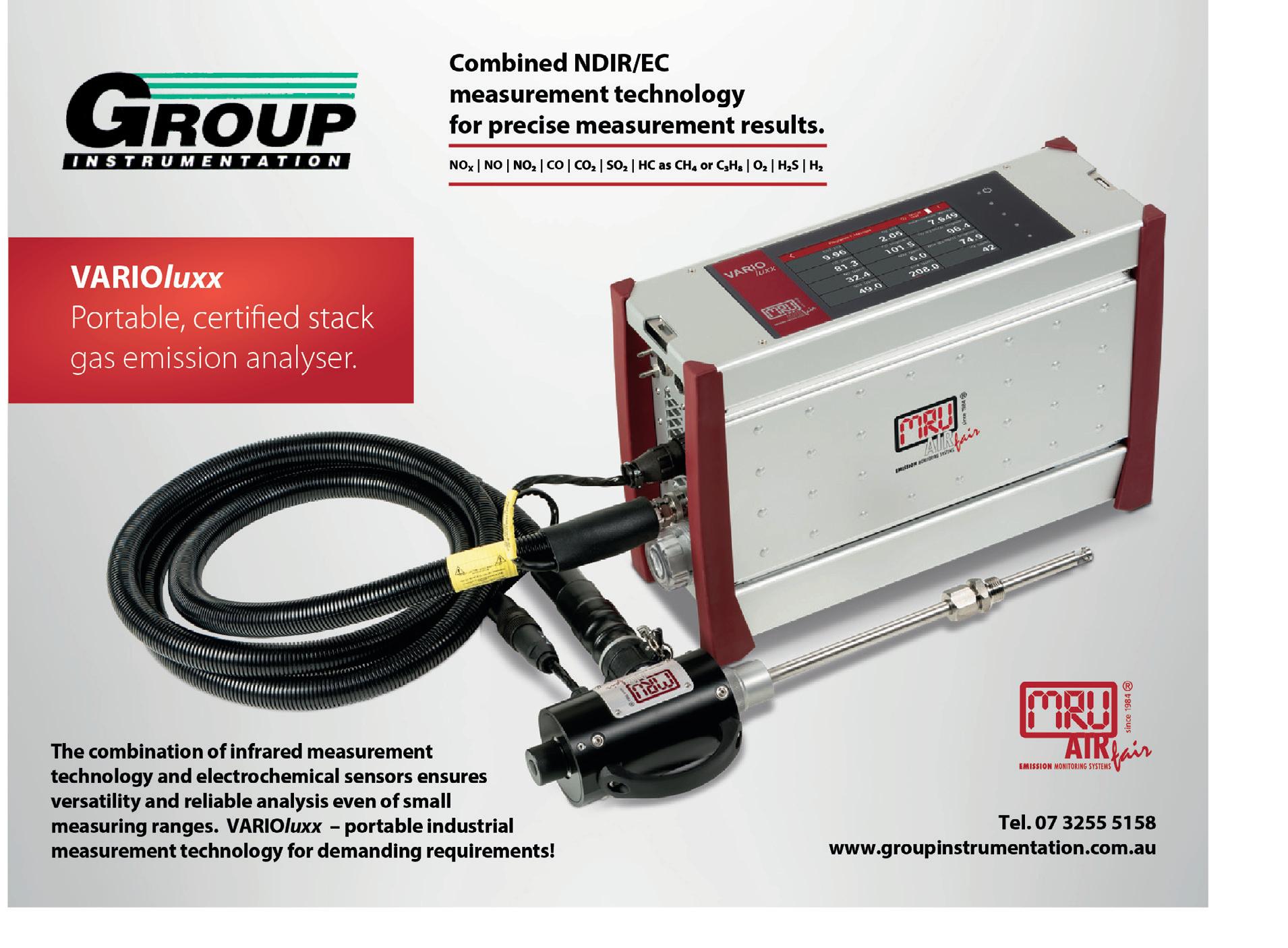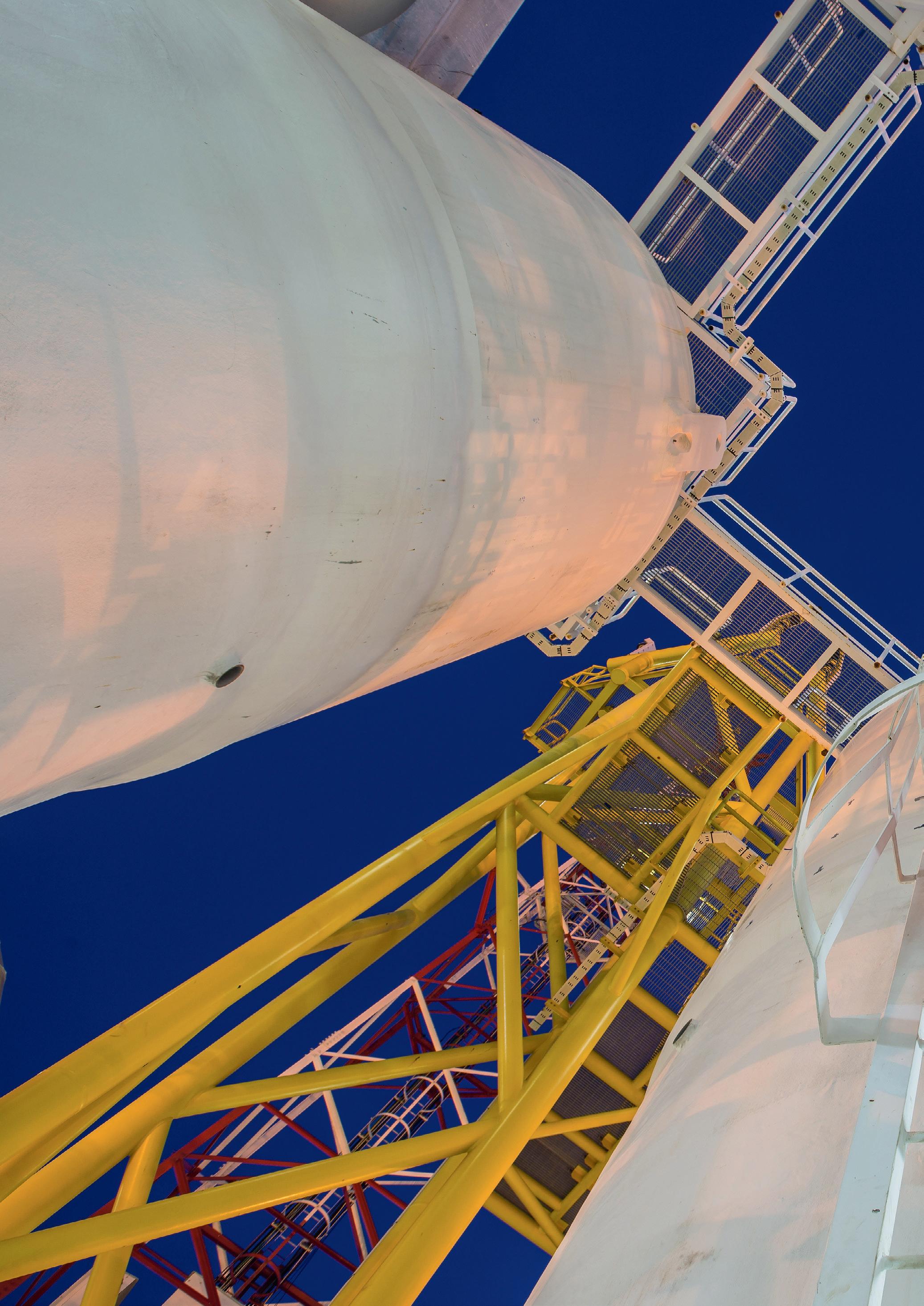
22 minute read
Knowledge is power

Treat maintenance as an asset, not an expense, by designing a datadriven strategy that improves asset and worker performance.
Today’s manufacturers face increasing expectations for asset management capabilities. According to the ARC Asset Management Trends November 2019 report1 , these expectations are driven largely by new requirements to support digital transformation initiatives. The result is a need for greater connectivity, visibility and information sharing both from within and outside of enterprises.
Additionally, you must maintain low operating budgets while increasing efficiency, and you need to optimise operations to sustain success.
One way to address such challenges is investing in a comprehensive asset management strategy. By executing a well-planned, comprehensive approach and implementing the right technology, manufacturers can transform maintenance from an expense into a strategic, competitive asset.
According to the ARC Strategies July 2019 report2 , Rethinking Asset Performance Management, successful asset management requires close cooperation between the maintenance, reliability, process engineering and operations functions in an industrial facility. New digitalisation tools can help make that cooperation easier.
Focusing on an asset management strategy can improve a range of metrics, such as overall equipment effectiveness (OEE) and return on net assets (RONA). In turn, these metrics contribute to aggressive productivity targets, including various forms of risk mitigation, datadriven decision-making, workforce empowerment and predictable expenditures.
Research shows why asset management must be a priority
Many manufacturers struggle to prioritise the time and investment needed to put a comprehensive asset management strategy in place, simply because so many other expenses compete for their limited budgets. But trends in manufacturing employment and other factors are converging to make asset management a major priority.
As an example, the US Bureau of Labor Statistics estimates a shortage of more than 2 million manufacturing workers by 2025, with more than 10,000 baby boomers retiring daily. According to LNS Research in its 2019 Connected Worker eBook3 , this impacts manufacturers as valuable skills, experience and institutional knowledge are lost. Although this intelligence gap appears daunting, an asset management strategy is relatively simple to initiate — especially if you rely on existing relationships with components distributors and vendors to develop customised, scalable solutions.
Some of the benefits of comprehensive asset management include: • Overall equipment effectiveness (OEE):
Driving uptime is key to a smart asset management strategy because it’s focused on assuring the people, parts and processes are optimised to support the equipment. It also provides trend data visibility into asset performance by both machine and shift, which helps drive continuous improvement priorities. • Return on net assets (RONA): Reducing inventory, maintenance costs and the number of downtime events raises productivity, while driving financial performance and predictability. • Empowered and engaged employees:
With fewer maintenance workers, those who remain need the right technology and tools to make good decisions about supporting plant performance.
According to LNS Research, the next generation of employees entering the workforce and advancing through the ranks are digital natives with an entirely new set of perceptions and expectations regarding technology and attitudes about work in general.
Maintenance is central to operations
Because equipment maintenance is one of the largest single controllable expenditures in a plant, it must be included in a life cycle plan. It also should be an integral part of any reliability improvement program, because it’s critical to machine throughput, availability and essential spare-parts stock.
Once you’ve organised your storeroom and have a repair strategy in place, you can optimise spare parts inventory and reduce the number of unnecessary parts. Digitally enabled platforms provide ongoing visibility into your installed base.
Also, data gathered and analysed as part of the process can be used to implement future improvements, such as developing a roadmap for managing the obsolescence and migration of ageing equipment.
To justify capital expenditure projects, maintenance needs to be considered central to productivity. Your storeroom is the starting point for strategic maintenance improvement practices, such as minimising equipment life cycle cost and maximising production equipment performance.
Getting started
Evolving asset management into a proactive, strategic component of bettermanaged manufacturing facilities can be done in phases, following three steps. Step 1: Evaluate needs, set goals The first step in any asset management strategy is examining your current situation while keeping in mind your business priorities, such as process validation over uptime or environmental impact over rate.
To establish a baseline for improvement, first understand your operation’s process hierarchy to determine equipment priority and thus risk.
Second, understand your equipment’s serviceable components and their life cycle status. For example, are the components new, available, repairable, replaceable or obsolete?
Finally, understand your storeroom content and identify all other locations holding spare parts.
This data will inform future decisions and allow immediate inventory optimisation. It also will support risk mitigation on the most critical equipment and provide the basis for all future management of your plant assets, including preventive maintenance (PM) program optimisation, storeroom optimisation, machine-builder changes and warranty capture.
Once you have completed data collection, assess critical areas of concern, outline needs for improvement and define your objectives so you can build an attainable asset management plan. Step 2: Design an asset management strategy Your goal-setting activities will yield the building blocks for your asset management strategy design, which likely will include these elements: • Maintenance, repair and operations (MRO) process management redesign • Reporting and dashboard creation • Excess spare parts burn, sell-off and/or vendor-managed agreement • PM activity changes MRO process management redesign A critical step is establishing best practices for part repair or replacement. Minimising your stock, optimising your repair process and building an actionable reporting structure is the most sustainable way to maximise your automation investment.
Reliability improvement uses a process risk assessment to track and understand the consequences of process and equipment failures, and recommend priority actions.
Optimising your repair process involves keeping track of where each individual component is in its life cycle. When a component on the line fails, you document where, when and why it failed, and determine if it’s under warranty.
To keep track of warranty detail and ease the process, the labelling system in your storeroom should include warranty information for each part to track its eligibility. Effectively managing your organisation’s warranty recovery can significantly contribute to the operation’s bottom line. Parts also should be tracked when sent for repair.
Typical savings categories for effectively managing MRO repair include: • Repair price versus new • Warranty recovery • Inventory and carrying cost reduction • Administration • New purchase and repair reduction • Increased production uptime
Having a person electronically track this data can help identify opportunities for system and process simplification or improvement.

Reporting and dashboard creation This phase can come in many forms and be accomplished in many ways. You might decide during the evaluation and goal-setting stages that an OEE information system is a necessary investment to create dashboards showing uptime, production rate and quality. The MRO process management redesign mentioned earlier also can provide significant information to be built into a usable and actionable reporting tool. Excess spare parts burn, sell-off or vendor-managed agreement Inventory reduction is a popular productivity target because it frees up budget for other assets. Remove or burn off excess or inactive inventory while filling in critical gaps you’ve found during the assessment.
Remember that you may have resources to help with your storeroom goal. For example, your local distributor may be able to help supply half of your needed parts from its available stock, leaving you to identify a plan for the remaining half. Also, your equipment vendor could implement an onsite parts management agreement, allowing you to avoid purchasing the remainder of the spare parts until they’re needed. PM activity change The more aware you become of your facility’s needs and challenges, the more fine-tuned and efficient your PM activities will become. You might choose to use vendor specialists with the resources to develop and sustain a PM program through scheduled service visits, fully warranted replacement parts and 24/7 remote troubleshooting — freeing your personnel to operate the equipment and manufacture products. Step 3: Implement your unique solution After establishing the right baseline of your facility and designing a plan that supports your business needs and mitigates your risk priorities, your asset management investment will be pointed, graduated and impactful.
The structure of your plan determines the implementation path. For example, you might be able to use your existing staff and processes to implement simple, immediate point solutions such as inventory disposition or burn-off. But when it comes to more complicated process implementations or redesigns, such as an MRO process redesign, seeking an external specialist to design and execute the right implementation plan might be an option. Step 4: Measure and continuously optimise the process The most successful asset management strategies evolve as equipment, process and people change. Therefore, be sure to investigate digital technology tools that provide a visual dashboard of critical plant assets and equipment changes.
After equipment purchases or retrofits, be sure to adjust inventory accordingly. This effort provides measurable data you can turn into actionable information to help inform future decisions to achieve continuous productivity gains.
The role of a reliability specialist
When production is lagging, unplanned downtime is mounting, maintenance budgets are shrinking and plant staff are overburdened, an asset management evaluation might be a good investment to help you regain your competitive edge and achieve your business goals.
With fresh eyes, an outside experienced professional can provide guidance that encompasses everything from inventory management, to employee training and workforce development, to plant-wide optimisation.
By understanding your environment, the consultant can help compare it to applicable industry standards and specifications, such as ANSI, TIA, ODVA, NIST, ISO, IEC, CE, OSHA, NERC CIP, Energy Star and DOE1. From there, your consultant provides recommendations for remediation and improvements to address any gaps, hazards and cost-savings opportunities, plus the applicable cost–benefit analysis.
In the case of a strategic maintenance consulting engagement, an asset management professional starts with a detailed evaluation of your current operation to understand your business priorities and company-wide goals, and to identify any potential inhibitors to your plant’s success.
Once those are identified, reliability solution consultants can develop a risk mitigation plan to help you increase production output while reducing costs through improvements to equipment and process reliability.
Often, a comprehensive mitigation plan includes safety improvements and reduced environmental impact. For example, when evaluating downtime during a risk assessment, an asset management professional analyses any potential fallout from such an event. If downtime endangers the environment or worker safety, the incident can pose far greater concerns to a company’s public image.
The goal is to transform maintenance from an expense into a strategic, competitive asset.
The right strategy
Leaders at smart companies know that successful asset management programs maximise uptime and offer other profitability benefits. With the right asset management strategy in place, you can achieve sustained growth and competitiveness. Resources 1. ARC Advisory Group 2019, Asset Management Trends, <https://www.arcweb.com/ blog/asset-management-trends> 2. ARC Advisory Group 2019, Rethinking
Asset Performance Management, <https:// www.arcweb.com/blog/rethinking-assetperformance-management> 3. Bussey P 2020, Connected Worker: Connecting People and Systems to Transform
Frontline Operations, LNS Research, eBook.
Rockwell Automation Australia
www.rockwellautomation.com/en-au.html

HOT PRODUCTS
ON WWW.PROCESSONLINE.COM.AU THIS MONTH

AIR SAFETY FUSES
The HoseGuard is a safety device that immediately shuts off the air flow should the volume of air exceed a set value.
Compressed Air Australia Pty Ltd
https://bit.ly/3lF1vn7 >

LOW DEW-POINT HYGROMETER
The Michell S8000–100 is a high-precision, low dewpoint hygrometer designed to meet the demands of humidity calibration and standards laboratories.
AMS Instrumentation & Calibration Pty Ltd
https://bit.ly/2VTJXL8

IO-LINK MASTERS AND HUBS
Turck has expanded its IO-Link range to include powered IP69K 8-port IO-Link masters, IP20 IO-Link masters and an I/O-Hub with external power.
Turck Australia Pty Ltd
https://bit.ly/3hTlddH
SERIAL GATEWAYS
DeviceMaster serial gateways are designed to connect any serial device to plant Ethernet or the cloud.

Pepperl+Fuchs (Aust) Pty Ltd
https://bit.ly/3tVpUZj


Artificial intelligence: saving water the smart way
VA SYD is one of Sweden’s largest utilities, which invests heavily in sustainable water and wastewater treatment, and pushes for environmentally smart solutions in community building. The company supplies more than 546,000 customers with drinking water in the regions around Lund and Malmö in the south of Sweden.
At VA SYD, non-revenue water accounts for 10% of all water supplied to customers. The reason: leaks in the pipeline network. VA SYD now relies on artificial intelligence to more efficiently detect and reduce leaks in water pipes.
“Treating natural resources with respect is a way of life in Sweden, and water use should be no exception to this practice,” Victor Pelin said. “Even if here in Sweden there is not a water-scarcity problem in general, wasting water just feels wrong. Plus, lifting, treating and pressurising water consumes energy, and energy is a major cost factor,” Simon Granath added.
Granath and Pelin work as development engineers at VA SYD and have been responsible for the design and implementation of the leakage detection system.
VA SYD operates a total of around 5000 km of pipelines, 2000 km of which are for drinking water. Pinpointing leaks is a complex task.
“Until very recently, we could detect only the largest leaks that led to service disruptions. In fact, it is the smaller, slower leaks, often from small service pipes, that are responsible for the lion’s share of non-revenue water,” Granath said.
“We have to maintain a lot of pipelines in a large area, and we wanted to improve our ability to pinpoint leaks through smart metering zones. For this purpose, we set out to find an AI-based solution,” Pelin said.
VA SYD evaluated several systems over recent years, looking for a solution that was state of the art. It would also have to make optimum use of the available flowmeters and smart meters in the area that had been chosen for the proof of concept. In the end they chose Siemens’ SIWA LeakPlus system.
“But when it came to the implementation concept, we ran into some obstacles,” Granath said. “We had to find a way of using the AIbased leakage detection in an on-premises set-up instead of a cloud environment. We then had some in-depth discussions with Siemens, their cooperation partner BuntPlanet, and our IT and OT departments about the best approach to install the SIWA LeakPlus solution in our own data centres.
“To my knowledge, this is the first time something like this has been done in the Swedish water industry — and we managed to get the job done.”
The next step was to refine the hydraulic models for the pipelines and link the data from the metering systems and pump stations with SIWA LeakPlus using OPC UA. VA SYD was then ready to perform the first tests.
Pelin explained: “We used the system to simulate different leaks and then evaluated the data. We were able to detect leaks as small as 0.5 litres per second — a huge improvement over the previous solution, which provided no means of detecting small leaks at all.”
SIWA LeakPlus is one of the Siemens Water (SIWA) applications specifically developed for the water and wastewater industry. The solution uses an AI-based algorithm to identify and classify anomalies in the pipe network. To perform reliably, SIWA LeakPlus is first trained with historical flow and pressure data so that it learns to separate anomalies from regular operation and assign the correct cause to each anomaly.
“In the coming weeks, we will introduce a further developed variant of leak detection, which will allow us to determine the exact location of the leak,” Pelin said. “Then we will have the means to really go out there and fix all those small issues efficiently.”
With the proof of concept in its final stages, Pelin and Granath are also working on scaling up the solution to other parts of the network. The next area to benefit from SIWA LeakPlus will be the town of Lund, where VA SYD is currently installing additional flowmeters to provide more data from the pipeline network.
“A smarter leakage detection system requires less data from the pipelines, so we can reduce the number of installed meters. This immediately pays off,” Pelin said.
Economic benefits aside, SIWA LeakPlus has already helped VA SYD take the next steps towards another ambitious goal: by 2030 the company wants to become a climate-neutral, energy-saving water utility with zero unplanned service disruptions.





WIRELESS MAGNETIC FLOWMETER
Endress+Hauser has developed the Proline Promag W 800 magnetic flowmeter for applications in remote areas where there is no possibility of supplying instruments with energy or transmitting data via cable. With battery operation, it is designed to allow maintenance-free, long-term operation for up to 15 years as well as worldwide secure data transfer via cellular radio. The product has a backlit display that makes reading the measured values easy, and the SmartBlue app is used for operation and comprehensive data retrieval on site. The device is also available with various drinking water approvals such as KTW/W270, WRAS BS6920, ACS or NSF 61. The instrument offers a maximum measured error of ±0.5%.
The transmitter includes measuring electronics, batteries, a data logger and a cellular radio module to send and receive data via LTE Cat M1, LTE Cat NB1 or EGPRS. The cellular module can be used to call up measured values and status messages online, such as flow, pressure, totaliser, device and process status, alarm messages and level of battery charge. End-to-end encrypted data transmission offers security in data transmission. In addition, the extended data logger safely stores up to 50,000 measured values or entries.
Users can order the unit with a specially certified corrosion protection (EN ISO 12944) and IP68 (Type 6P) degree of protection, which completely prevents water ingress. The instrument also supports Endress+Hauser’s Heartbeat Technology to remotely monitor functionality and calibration.
Endress+Hauser Australia Pty Ltd
www.au.endress.com
RADAR LEVEL TRANSMITTER WITH IO-LINK
To meet the need for highly accurate level measurement in hygienic applications, Emerson has developed the Rosemount 1408H Level Transmitter, which the company says is the world’s first non-contacting radar device designed specifically for the food and beverage industry. Non-contacting radar is a suitable level measurement technology for applications that require stringent hygienic facilities and equipment. It has a top-down installation that reduces the risk of product loss through leakage, and it is unaffected by process conditions such as density, viscosity, temperature and pH. The compact form of the Rosemount 1408H makes it a suitable solution for the small tanks and spaceconstrained skids commonly used in food and beverage production. The hygienic antenna is flush with the process connection in order to facilitate the removal of process residue during clean-in-place and sterilise-in-place processes.
The Rosemount 1408H uses 80 GHz frequency modulated continuous wave technology on a single electronic chip with embedded smart algorithms. This enables stronger radar beam focusing, so that internal tank obstructions such as agitators can be avoided and greater measurement accuracy achieved. Fast sweep technology also means collecting up to 40 times more information, increasing accuracy. The technology also enables measurements all the way to the top of the tank by eliminating radar dead zones.
The Rosemount 1408H is also said to be the first non-contacting radar transmitter with connectivity via the IO-Link communication protocol, making it easy to integrate with any automation system. The transmitter provides conventional analog 4–20 mA, switch outputs and digital high-speed communication.
Emerson Automation Solutions
www.emerson.com/au/automation
FRONT-FLUSH LEVEL SWITCH
VEGA has developed the VEGAPOINT 24 front-flush level switch especially for use with very sticky, viscous or abrasive products, particularly in the beverage, food and pharmaceutical industries. The company says that even with the strongest build-up, it reliably detects the level of coverage and indicates it with a coloured illuminated ring that is visible from a distance.
The VEGAPOINT 24 is a plug-and-play sensor that can be installed easily with a few simple steps. Flexible production systems with frequent and fast product changes benefit from the fact that it detects all media with the help of the default setting without adjustment. Extended functions, such as interface detection or foam blanking, can also be configured easily.
The front-flush design of VEGAPOINT 24 is designed to allow more application possibilities. Cleaning pigs can work safely alongside the sensor due to its flat metal measuring tip that is said to even cope with sandblasting.
VEGA Australia Pty Ltd
www.vega.com/au



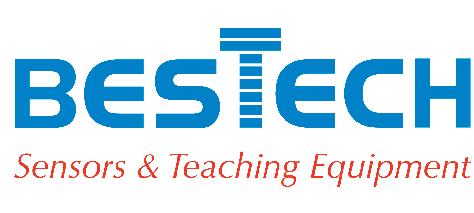
ELECTROMAGNETIC FLOWMETER WITH PoE

ABB has incorporated power supply through Ethernet connectivity on board its ProcessMaster electromagnetic flowmeter. Power over Ethernet (PoE) omits the need for a separate DC power infrastructure, providing power and communications via the same cable. This brings new agility as flowmeters can be installed wherever needed. In addition, ABB 4-wire Ethernet combines classic outputs with future communication protocols. Offering a modular design allows the combination of both worlds and helps ensure that devices are futureproof, increasing the longevity of the flowmeters.
Flowmeters with Ethernet connectivity increase simplicity, flexibility and reliability for operations in process automation, while enhancing real-time visibility of data. Previously hidden data in field devices, such as measurement values on density, conductivity or concentration of the medium, can be made available. This in turn will help users identify redundant measurement points in their plants to achieve savings along the way.
Combining 4–20 mA or digital outputs with new 1- or 2-port Ethernet helps makes classic instrumentation futureproof, with speeds of up to 100 m/s. The flowmeters use various Ethernetbased communication protocols, such as simple Modbus TCP or EtherNet/IP. This prepares them for IT/OT convergence, cloud connectivity and the requirements needed for secure and encrypted communication in the near future.
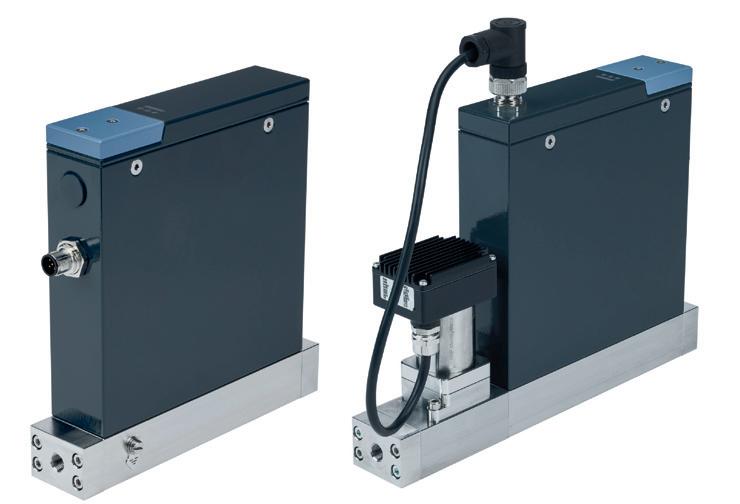
ABB Australia Pty Ltd
www.abbaustralia.com.au
CORIOLIS MASS FLOW METERS
The smallest quantities of substances have to be measured and controlled reliably and precisely for applications in thin film coating technology, test benches, micro reaction technology and the food and beverage industry, for instance when dosing aromas or fragrances.
The Type 8756 mass flow meters from Bürkert Fluid Control Systems are based on the Coriolis measuring principle, which determines the mass flow independent of pressure and temperature. They are characterised by their high flow measuring accuracy of ±0.2% in the measuring range ±0.0014 kg/h and operate with a high level of repeatability, even at very low flow rates. The sensor is suitable for a flow range up to 25 kg/h for water or media with similar dynamic viscosity and offers a fully usable measuring range of up to 1:250.
All parts which come into contact with media are made of high-quality stainless steel (AISI 316L), thus ensuring a high level of chemical resistance, even for aggressive media. The devices can be used for any kind of liquid with dynamic viscosities between 0.3 mPa·s and 200 mPa·s, which reduces the number of components and simplifies storage. Type 8756 is available as a plain mass flow meter (MFM) or mass flow controller (MFC) with integrated micro annular gear pump. The MFC is able to readjust any deviations from the setpoint value in less than 1 s.
Burkert Fluid Control Systems
www.burkert.com.au
The model FSD-4 electronic flow switch from WIKA is designed to offer flexibility in monitoring and controlling flow based on the velocities of liquid media.
The switch points of the model FSD-4 can be freely configured via the 3-button operation directly on the instrument or optionally via IO-Link.
The flow switch can output both absolute values in various units and relative flow values and display them on the digital indicator. While a flow rate value is assigned to the first switch point, it can be defined at the second switching output whether the switch should switch at a second flow value or at a specific temperature value for the medium.
In addition, the FSD-4 can be fitted with an analog output for flow or temperature values. The wide range of parameterisation options makes the model FSD-4, with only three basic variants, a suitable flow switch for a wide variety of applications and installation situations.
WIKA Australia
www.wika.com.au
ELECTRONIC FLOW SWITCH
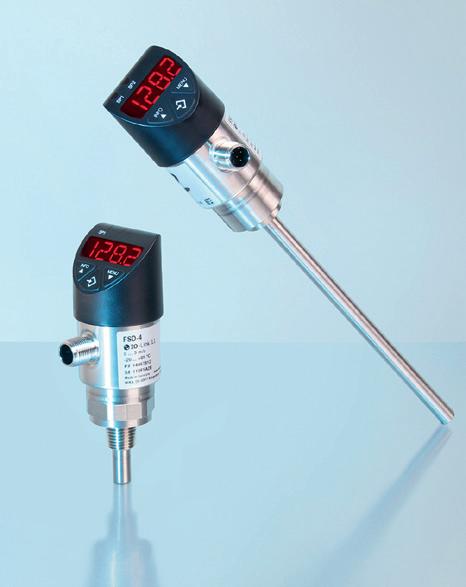
LASER LIGHT BAND SENSORS

The BLA series laser light bands are designed for when different objects have to be identified in various production, packaging or quality control situations.
The IO-Link through-beam sensors offer numerous measuring modes such as object diameter, object position, gap width, gap position and edge position. Various light band sizes allow the user to perform nominal/actual comparisons even with narrow objects like wires or wider objects such as shafts. Users can simultaneously use the built-in operating hours counter to monitor processes and display maintenance intervals.
IO-Link enables centralised data management and storage and, with it, simple and fast configuration, making it possible to easily change formats during the production process. Processed analog signals can also be easily transmitted.
The series can be used for tasks such as precise position detection, object classification and simple part sorting by size or diameter. Variables like object height, gap dimensions or holes can be monitored for quality assurance. Precise detection of web edges is also possible, even with semi-transparent materials. With a large selection of housing sizes, they can be mounted in applications with tight spaces and in hard-to-reach sensing positions.
Balluff Pty Ltd
www.balluff.com.au
